Parrots and finches require a specialised and healthy diet that does involve a lot of cooking and preparation. Proper nutrition is critical in terms of raising a healthy pet. Depending on your views, you can feed anywhere from 50% fresh to 50% pellets, to 85% fresh and 15% pellets/seeds. I choose the latter. To me, feeding less than 50% fresh food is too little.
Diet has become my obsession. It is so important to our pet birds, and also quite complex! Did you know that through changing how you feed, you can solve, or at least help, many behavioural issues in parrots – including hormone-related ones?
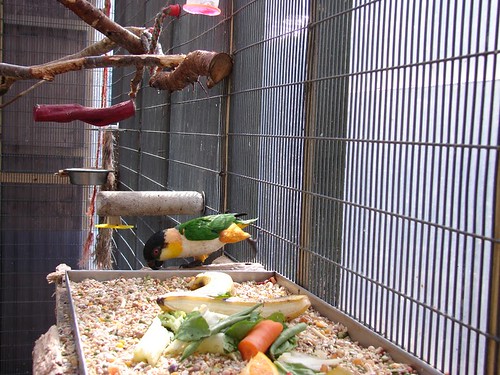
I have helped my Senegal’s hormones by changing his diet, and am currently working with other birds and their owners in the process of fixing behavioural issues through nutrition. It is not the easiest thing to do, but with a bit of work, you can put your bird on the path to feeling great.
An all-pellet diet is just as bad as an all seed diet. It is damaging to the liver and system in general, and is boring besides. With birds who come from an arid environment in the wild (such as parrotlets, cockatiels, and lovebirds), an all-pellet diet can even be deadly. To put it into perspective, a poor avian diet is like feeding a child nothing but sweets and crisps every day for every meal. Imagine the internal damage, even everything outwardly seems to look okay.
Just how important are diet and nutrition to a pet parrot?
Answer: Many behavioural problems boil down to diet, according to the Island Parrot Sanctuary.
You can fix – or at least help – biting, screaming, and plucking through the addition of proper diet. That leaves the question of what is a good, healthy diet for my bird?
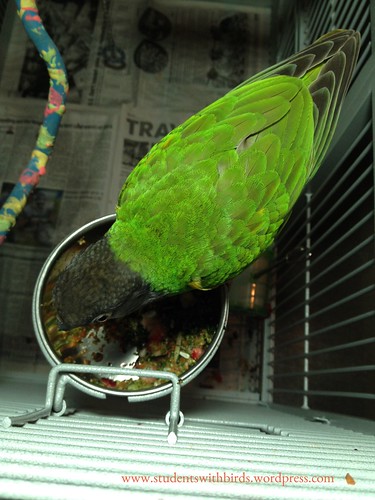
Feeding parrots right consists of the following elements:
- Fresh vegetables and small amounts of fruit, mostly raw
- Grains, legumes, and beans
- Seeds and nuts as treats or snacks, in moderation
- Sunlight
It also varies per species. We tend to speak in terms of wide, sweeping generalisations about parrot nutrition, but the truth is, parrots species all have specific requirements. Yes, they each need fresh veggies and fruit in moderation, but many require more consideration than just that. African Greys, for instance, require extra calcium. Parrotlets in the wild do eat seed, as do cockatiels. Many species of macaw need extra fat through nuts. Lorikeets – adorable little birds – are nectar-drinkers, and require the most specialised diet of all.
Experimenting with avian diet is wonderful. Just keep your vet involved, because this is something that affects a bird’s health in so many ways.
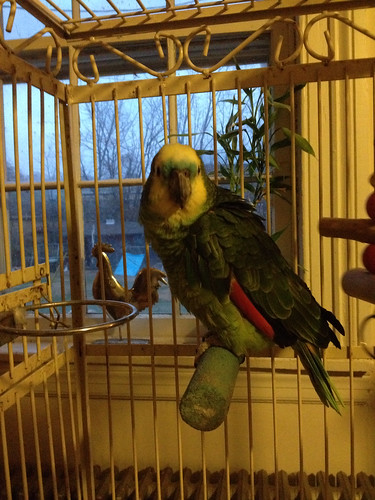
How do I convert my parrot to a healthy diet, or get him to eat new fruits and vegetables?
Diet conversion is a tough battle for many owners. It took us over a year of experimentation to get our parrotlet to so much as consider trying new foods, especially vegetables. He used to hate new food. Parrots do not instinctively know what is edible; nor do they know what is bad for them. They learn by example, in both captivity and in the wild. When they’re captive, we humans have to teach them what is good and healthy. This can take months of time and effort. The question of how to get your parrot to actually eat his vegetables boils down to the individual.
What is toxic to a pet parrot? The ‘toxic foods’ list for pet parrots is relatively small. In general, you can feed a pet parrot anything you might eat yourself, so long as you can guarantee it is fresh, healthy, and free of salt, fat, sugar, and other additives. Do NOT feed the following:
- Avacado (due to fat content this is deadly to captive birds)
- Raw garlic or onion
- Chocolate
- Alcohol, sugary drinks, fizzy drinks, or caffeine
- Salt and sugar
- Fatty foods
- Peanuts
- Fruit pits and seeds, including peach, pear, apple, apricot, cherry, or plum
- Nutmeg
- Rhubarb
- Raw honey
- Raw tomato
- Mushrooms
- Grit (parrots hull/shell their seeds, so this is NOT necessary, and is in fact deadly)
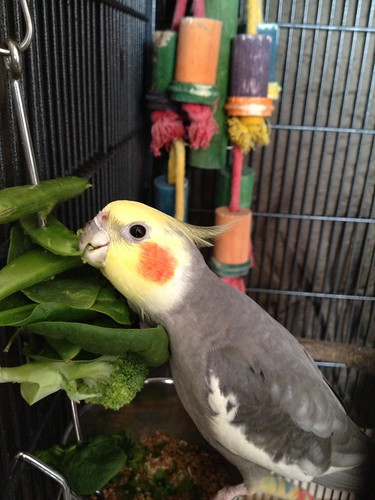
What kind of foods are safe for my parrot? This list is expansive and wonderful, bringing plenty of enrichment to your parrot’s life. This is not a complete list; Cockatiel Cottage has a good list of ‘safe’ foods, as does the Parrot’s Pantry group on Facebook.
- Vegetables and herbs: basil, thyme, beets, beet tops, broccoli, bok choy, mustard greens, endive, water cress, collard greens, spinach, Swiss Chard, Romaine letttuce, red lettuce, kale, dandelion greens, cilantro, carrots, carrot tops, sweet corn on the cob, rutabaga, turnips, turnip greens, parsnips, radish and radish tops, sweet potatoes, yams, squash, pumpkin, cucumber, zucchini, peas, dandelions, sprouts, bell peppers, hot peppers, parsley, green beans, string beans, fennel, cauliflower.
- Grains, seeds, and legumes, cooked: beans (such as mung, pinto, lima, wax, etc.), whole-grain pasta, quinoa, wild long-grain rice, cous cous, brown rice, oatmeal, barley.
Plus the following are generally considered safe in moderation, but shouldn’t be fed daily or in large amounts:
- Cabbage, eggplant, asparagus, celery, cooked potato, unsalted popcorn, cooked eggs with shell
- Citrus and other acidic foods: lemon, lime, grapefruit, orange, tangerines, clementines, cranberries, cooked tomato
- Fruits: apples, pears, apricot, cherries, mango (no skin), papaya (with seeds), watermelon (seeds are safe), star fruit, grapes, cantaloupe, berries, etc., due to the natural sugar content
- Seeds and nuts: safflower, sunflower, hemp seed, flax seed, pine nuts, walnuts, pistachios, pumpkin seeds, millet, etc.
- Dairy is much debated, but birds are not equipped to digest it, and so are often lactose intolerant. Only feed dairy in tiny quantities, knowing the risks.
A note about Tofu: Tofu is made with soy, and soy often stimulates breeding hormones in parrots. While technically safe, this is one food I choose to forgo.
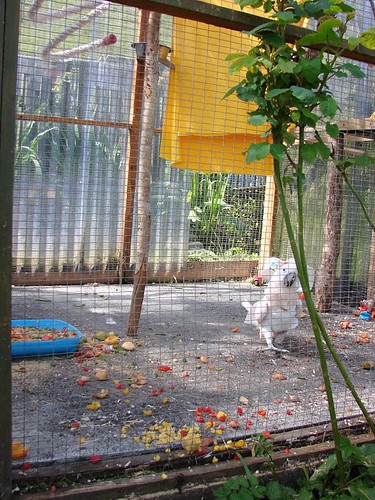
Should I be feeding cooked, or raw?
Raw is generally best. Cooking can deprive a food of nutrients, but, in things like sweet potatoes or carrots, it helps by breaking down nutrients and making them easier to digest. Heating up food, however, has advantages of its own in that you can provide extra variety once in awhile. Steaming is often your best bet. Chop for parrots is an example of feeding raw and super healthy.
What role does sunlight play in my parrot’s nutrition?
This is an important question, one that I feel needs to be addressed more in the bird community. Parrots and finches both need the sun. Without it, avians simply do not get the most out of their diet, or grow their best feathers. UV encourages healthy feather habits (reducing the likelihood of plucking or feather barbering), and helps birds feel generally better and healthier – meaning less biting and screaming! Read more about the importance of sunlight to parrots.
An aviary or UV-A lamp beside the cage will help your parrot immensely in a number of ways.

Can I feed my bird meat like fish, pork, chicken, or beef?
It’s true that you can also safely feed cooked meat to your parrot up to twice a week, but many choose not to. This is not a necessity for a captive parrot. It may be interesting to know that species, like wild Amazon parrots, will actually canibalise their own dead. How often would an average wild parrot actually eat eggs or meat, though? Probably not that much.
As to eating chicken, parrots are a completely different species, so it is not cannibalistic. They are utterly unrelated.
Note: Protein typically causes hormonal issues. Start by cutting back on protein intake to reduce a parrot’s hormones. Pellets ARE a culprit here, especially ones with soy.
Do I need to feed pellets? (Alternatively, ‘Does my parrot need pellets in his diet?’)
This is a tricky question. I am currently experimenting with going pellet-free. Parrots would not be eating pellets in the wild, just like meat, and so this is one I don’t feel too bad about cutting out. It does require a lot of extra work to keep your parrot nutritionally balanced. You can’t just feed seed instead, as that will result in health problems of a different kind.
Obviously, we can’t mimic the wild diet (hence feeding vegetables like kale, which they would not see!), which is where pellets could potentially come in. Look out for the pros and cons of feeding a parrot pellets. This is too long to debate in a few sentences here and now.
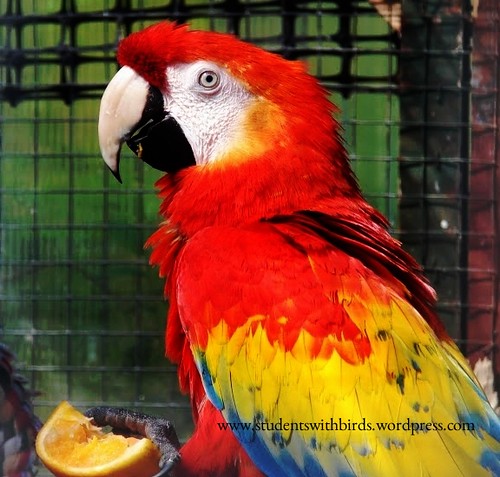
My parrot wouldn’t eat these fruits and vegetables in the wild, just like pellets!
This is very true, but we are not able to offer exactly what a parrot would eat if left in its natural habitat. There are many things that wild parrots eat that are actually toxic to our captive birds – perhaps in part because of the mineral sources they flock to and ingest. In an owner’s case, offering fresh fruits and vegetables becomes about getting them the right nutrition for their current situation (cage or aviary living), and providing enrichment through it.
Besides this, we have to take into consideration the fact that wild parrots burn off much more energy than our captive ones, since they fly many miles each day in search of food. Captive birds need far fewer calories. Basically, we have to modify their diets in captivity to keep them healthy. The amount of fat that a parrot in the wild could tolerate differs because of what it is doing.
What birds need vegetables in their diet?
To conclude, all birds need healthy fruits, grains, and vegetables. Each and every one benefits from eating well – from zebra finches to canaries – and macaws, cockatoos, budgies, cockatiels, parrotlets, and all other parrots. Just like people.
Want to start to fix your bird’s biting or screaming? Begin with diet.
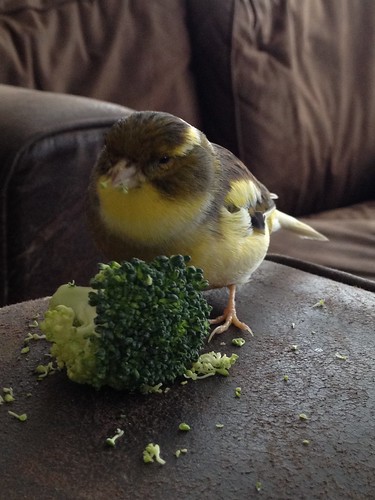

Nice post. Charlie is a fussy eater. I suspect she was only fed seeds before she came to live with us. We get her to try new foods by letting her out when we eat dinner. If she sees us eating something, she wants to try it. I know that probably sounds weird to non bird people but it works. I keep offering a variety of fresh raw food in her bowl. When she doesn’t like something it quickly gets flung to the floor.
LikeLike
Thanks – Ptak is also a very fussy eater. Frustrating! I believe it has to do with the environments their species come from. I think lovebirds eat mainly seed and berries in the wild (a lot like parrotlets), which probably makes them inclined towards pickiness in captivity.
As I read your comment, Mavi was chucking his supper over the edge – you’re not alone! Eating something is definitely a great way to encourage your bird to try new things. It works for Mavi, but not so much for Ptak. He’ll make a cute lip-smacking noise, though, if he wants some, haha!
LikeLike
Lovely blog as always. When we had Clyde, he had his favourites and was insistent that he wouldn’t eat root vegetables in the main…although he loved mash potato. He loved porridge too. For some reason when they trust you, he would always try things once again like banana even though he didn’t like it. Very fussy…and he couldn’t be fooled! 😃
LikeLike
Huge commitment. And what a great entry for people who have parrots. I didn’t know that birds and dairy don’t get along. It’s similar with cats I believe. I love the photos!
LikeLike
Thanks! We do cheat and give our cats a little milk once in awhile. We had one rescue cat who hated my dad at first… Once he started giving her milk, though, they became besties, haha.
LikeLike
Oh yes, they do love it. That is very sweet — BFF’s!
LikeLike
Wonderful article!! Very detailed with so much great information. Proper diet is also important for Finch owners as well, though our fresh foods mostly come pre-packaged but still organic & super healthy. I wish Finches would eat fresh fruits & veggies! But most of the time I have to hide them in hard-boiled eggs and they only eat them on accident, fussy brats they are. Finches are especially finicky about food so I feel your pain with Ptak. High protein foods cause issues with Finches also, encouraging them to breed and become territorial or generally aggressive. Really interesting. Thanks for sharing!!
LikeLike
LOL, fussy fits little Ptak, but our Pip (canary) eats ANYTHING. She taught our parrots to eat veggies. I miss my sweet canary. Protein has much the same affect, then, on both species. I didn’t know that! Makes sense, though. Feeding these little guys isn’t easy!
LikeLike
I’m sure feeding parrots is much harder than feeding Finches! 🙂 All you need for Finches are the pre-packaged (but still fresher than the dickens) organic foods. Pip is an impressive little gentleman, I wish he would come teach my flock how delicious real food can be without having to hide it in hard boiled eggs. Lol!
LikeLike
I used to read your old site so am really happy to find you still writing, especially about parrots. The post was well written and speaks of experience and research and I really wish more people have access to this, especially people who rely on pellets to fix everything. I feed pellets too, but the pellets I feed is TOPs organics, they are cold pressed pellets with natural ingredients and nothing that you can’t pronounce. No: artificial colours, flavours, vitamins, preservatives, sugar, GMO free, no animal products/by-products, BHA, BHT, soy, etc. The ingredients are amazing, the best I’ve seen: alfalfa leaf, quinoa, dandelion leaf, spinach leaf, orange peel, kelp, rosemary leaf, cayenne and so much more.
I think I’ve been feeding my tiel this pellet for years now, at least 5-6 and she still loves it, still goes crazy for it. The only bad side is there are no fillers, no corn and soy and things like that, so your parrot will need A LOT more than you’d think to fill them up. Which isn’t great for your wallet but hey, we go through all this effort to keep them healthy so we can’ complain.
So there are pellets out there that can be included, can be a PART of their diet, but only if you do your research.
LikeLike
This is a very informative post. I love how deep you dive into the foods that are good and the foods that are not good! https://birdnerdorg.wordpress.com
LikeLike